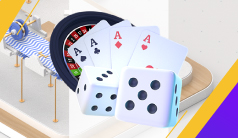Counting Cards
Counting cards is the final piece of the strategic blackjack puzzle. With a bit of practice, you can gain an advantage over the house, know when to press your bet, and predict the next card at the table.
Contrary to popular belief, you don’t need to be a genius that’s amazing at math to count cards. If you can quickly add or subtract by 1 or 2 and keep a running total in your head, you have what it takes to at least get started.
Our blackjack card counting guide covers all the bases. We’ll show you how to use the easiest systems, when to raise your bets, and where to put your tactics to use.
Blackjack Card Counting
Table of Contents
Best Casinos to Play Blackjack Online
Blackjack is available at several online casinos. Sign up for an account at any of the following online casinos to play for real money today.
| RANK | ONLINE CASINO | BLACKJACK GAMES | BONUS | START |
|---|---|---|---|---|
| 1 |  DuckyLuck Casino DuckyLuck Casino | BLACKJACK GAMES 6 | BONUS 500% up to $7,500 | Play Now |
| 2 |  Bovada Casino Bovada Casino | BLACKJACK GAMES 10 | BONUS 125% up to $3,750 | Play Now |
| 3 | 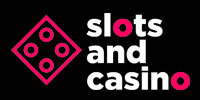 SlotsandCasino SlotsandCasino | BLACKJACK GAMES 6 | BONUS 500% up to $7,500 | Play Now |
| 4 |  BetUS BetUS | BLACKJACK GAMES 22 | BONUS 150% up to $3,000 | Play Now |
| 5 |  Super Slots Super Slots | BLACKJACK GAMES 21 | BONUS 250% up to $6,000 | Play Now |
What is Counting Cards?

Card counting systems aim to give you a better idea of the value of the next card in the deck. They are popular in games like blackjack and poker, where the deck depletes over several hands.
So, how do you determine when you’re more likely to see specific cards and, in turn, when to raise your bets? The count increases as more low cards get removed from the deck or shoe. The count decreases when more high cards are played than low ones.
Therefore, the higher the positive count, the more high-valued cards we know remain in the shoe. Since high-valued cards make the dealer bust more often and help the players with their double downs, the greater the positive count, the better chances you have to win.
How Blackjack Card Counting Works
This short video shows you the basics of how to count cards in Blackjack, keep a running or true count, and increase your odds of beating the house.
Before You Begin Counting Cards
Counting cards in blackjack can give you an edge, but there are a few things to remember before you begin.
Know The Game
Card counting is an advanced strategy that adds a layer of complexity to the base game. Learn the ins and outs of how to play blackjack and memorize the basic strategy chart first.Play With a Live Dealer
To count cards, you must be in a land-based casino or, at the very least, a streaming live dealer table with real cards. These systems don’t work with software-based games since you don’t see other players’ cards. Plus, the shoe usually gets shuffled after each hand.Be Discrete
If you plan to put the tactics on this page into practice, you’ll want to be discrete. While it’s not illegal to count cards, casinos aren’t the biggest fans of advantage players. If caught, you may be asked to stop playing, leave, or even be trespassed (banned).
Blackjack Card Counting Doesn’t Work Well Online

You can and should use online blackjack games to learn how to count cards and gain experience, but you won’t gain much advantage.
Online casinos have made card counting nearly impossible. In software-based games, the virtual cards get shuffled at the end of every hand, so you’ll never get a running count.
Even the live dealer blackjack games know about card counters and take measures to avoid losing money. Many studios shuffle at 50% of the shoe, which makes it hard to get a good read, so proceed with caution.
How to Count Cards in Blackjack | A Guide with Examples
The core premise of card counting is keeping track of all previously played cards so you know what remains in the dealer’s shoe. To simplify that, you only focus on the value, not the suit. But how do you apply this information?
As gameplay progresses, you’re taking in all the available information on the table and using some simple math to determine the best time to deviate from the basic strategy. The concept is simple, but it’s not quite as easy as it sounds.
This step-by-step guide shows you exactly how card counting in blackjack works from start to finish. The example uses the Hi-Lo system, one of the easiest and most popular methods.
Assign a Value to Each Card
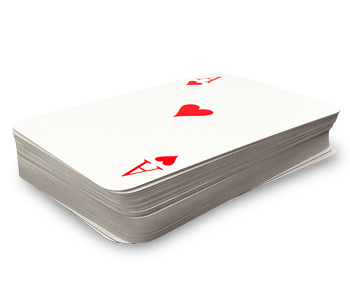
In all blackjack card counting systems, each card in the deck gets a positive, negative, or zero value.
These values help determine if the shoe has a higher concentration of low or high cards. And that extra foresight starts to give you an edge over the house.
Hi-Lo System Example
The card values in the Hi-Lo card counting system are as follows:
- 2, 3, 4, 5, and 6: +1
- 7, 8, and 9: 0
- 10, J, Q, K, A: -1
Keep Track of The Running Count
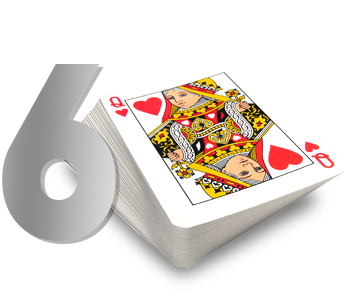
At the beginning of the shoe, you start with a count of zero. When the dealer passes out the first card to you or another player, you either add or subtract its value. A negative number means you subtract, and a positive number means you add. The number you get after the first card is your new running count.
With each consecutive face-up card, you add or subtract its value from your most recent running total to get a new count. You continue the process with every card you see until the dealer shuffles the cards or gets a new shoe.
Hi-Lo System Example
You’re at a table with two other players, the dealer, and a new shoe. Below, we’ll see how your count moves with each card that comes out of the shoe.
- The count starts at 0.
- You get a 6 (+1). The count is now at +1.
- The other players get a Jack (-1) and a 7 (0), bringing the running count down to 0 again.
- The dealer shows a King (-1). The running count goes to -1.
- Your second card is a 9 (0), leaving the running count at -1.
- The other players get a 4 (+1) and a 6 (+1), bringing the current count up to +1.
- The dealer gets a face-down card, so you don’t adjust the count for that yet.
- You hit, get a 10 (-1), and bust. The running count goes to zero.
- The first player hits for a 4 (+1) and stands. The second player hits, gets a 9 (0), and stands. Now the count goes up to +1.
- The dealer turns over their face-down card. It’s a 4 (+1). They hit based on house rules and get another 4 (+1) before standing. The running count goes up two points to +3.
- The dealer determines the winners and losers and clears the cards from the table.
- The +3 count we got at the end of the first hand carries over and is the number you start with for the next round.
Calculate the True Count
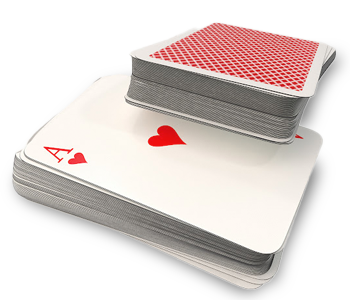
Simply put, the true count is the running count divided by the number of decks remaining in the shoe. This adjusted number gives you a more accurate idea of the concentration of the high-value cards remaining in a multi-deck game.
As cards deplete from the shoe, there are fewer and fewer decks remaining. That means you need to adjust the number you’re dividing by as the discard pile grows.
Pro Tip: If you’re new to counting cards in blackjack, stick to single-deck games. A running count is all you need when there’s only one deck in play since you only divide by one for a true count, getting the same value as the running count.
Hi-Lo System Example
Let’s say the example above is at a table with six decks in the shoe. Below are the true count formulas you would use throughout the game.
- At the end of the first hand, we determined the running count was +3. Since most of the six decks remain, we divide the count by six. +3 / 6 Decks = A true count of +0.5
- After ten hands, the count tripled, going to +12. By now, about two decks of cards have depleted from the shoe. With only four decks remaining, we divide our running count by four. +12 / 4 Decks = A true count of +3
Use The True Count to Adjust Your Bets

To take full advantage of a favorable shoe, you should adjust your bets as the true count changes. There is a formula to calculate the recommended wager anytime the true count exceeds +2.
To get the recommended wager, take the current true count minus one and multiply that by your standard betting unit. Just remember, you’re always betting at least one unit.
Pro Tip: Managing your bankroll in blackjack is an important part of the strategy. When counting cards, you must have enough money to cover a streak of losses. We suggest setting your standard betting unit at the table minimum and buying in with at least 100x that amount.
Hi-Lo System Example
Sticking with the examples above, we’ll assume your base betting unit is $5 per hand and use the suggested bet formula to figure out your next wager.
- The first true count was +0.5. Since +0.5 is less than +2, you would continue to bet one standard unit, or $5.
- After ten hands, we got to a true count of +3. Since +3 is greater than +2, we use the betting formula. True count of 3 – 1 = 2 and 2 x $5 standard bet = a $10 recommended wager.
Is Counting Cards Illegal?
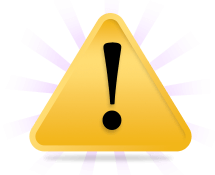
According to local, state, and federal laws, card counting is not illegal in the United States. However, casinos reserve the right to refuse service.
In popular gambling destinations like Las Vegas or Atlantic City, if they believe you are counting cards, they will ask you to stop playing. Some venues will still let you play other games but won’t let you play blackjack anymore.
If a casino is particularly unhappy with you, they can read you the tresspass act, which makes it illegal for you to be on their property. Additionally, players cannot use assistive devices, have someone assist, or communicate information to other players that would give them an advantage.
Popular Blackjack Card Counting Systems
There are dozens of card counting systems that blackjack players use to gain an edge over the house. They consist of single or multi-level methods, balanced counts, and unbalanced approaches.
The changes usually include specific card value shifts or a slightly different way to calculate the running or true count from one to the next. Play with a few of them to determine which works best for you.
Balanced Counts
A balanced counting system starts at zero with a new shoe and ends back at zero when all cards have been played. The most popular example is the Hi-Lo method.
Below is a list of balanced card-counting systems used in blackjack.
Hi-Lo
The Hi-Lo system is the most commonly used card-counting method. It is easy to learn and excellent for beginners.
| Card | Count Value |
|---|---|
| 2 | +1 |
| 3 | +1 |
| 4 | +1 |
| 5 | +1 |
| 6 | +1 |
| 7 | 0 |
| 8 | 0 |
| 9 | 0 |
| 10 | -1 |
| J | -1 |
| Q | -1 |
| K | -1 |
| A | -1 |
Hi-Opt I
The first Hi-Opt system is only a slight variation of the Hi-Lo method. Another relatively simple way to count.
| Card | Count Value |
|---|---|
| 2 | 0 |
| 3 | +1 |
| 4 | +1 |
| 5 | +1 |
| 6 | +1 |
| 7 | 0 |
| 8 | 0 |
| 9 | 0 |
| 10 | -1 |
| J | -1 |
| Q | -1 |
| K | -1 |
| A | 0 |
Hi-Opt II
Hi-Opt II is a multi-level count meaning some cards are worth ±2 at a time. It is a more advanced technique.
| Card | Count Value |
|---|---|
| 2 | +1 |
| 3 | +1 |
| 4 | +2 |
| 5 | +2 |
| 6 | +1 |
| 7 | +1 |
| 8 | 0 |
| 9 | 0 |
| 10 | -2 |
| J | -2 |
| Q | -2 |
| K | -2 |
| A | 0 |
Omega II
The Omega II method is a multi-level counting system. Some counters find it to be more efficient than Hi-Lo.
| Card | Count Value |
|---|---|
| 2 | +1 |
| 3 | +1 |
| 4 | +2 |
| 5 | +2 |
| 6 | +2 |
| 7 | +1 |
| 8 | 0 |
| 9 | -1 |
| 10 | -2 |
| J | -2 |
| Q | -2 |
| K | -2 |
| A | 0 |
Zen Count
The Zen Count is a two-level card counting system often employed by intermediate or advanced players.
| Card | Count Value |
|---|---|
| 2 | +1 |
| 3 | +1 |
| 4 | +2 |
| 5 | +2 |
| 6 | +2 |
| 7 | +1 |
| 8 | 0 |
| 9 | 0 |
| 10 | -2 |
| J | -2 |
| Q | -2 |
| K | -2 |
| A | -1 |
Wong Halves
The Wong Halves system is not for the faint of heart. It’s a complicated counting method used by the pro.
| Card | Count Value |
|---|---|
| 2 | +0.5 |
| 3 | +1 |
| 4 | +1 |
| 5 | +1.5 |
| 6 | +1 |
| 7 | +0.5 |
| 8 | 0 |
| 9 | -0.5 |
| 10 | -1 |
| J | -1 |
| Q | -1 |
| K | -1 |
| A | -1 |
Unbalanced Counts
Unlike the balanced formats above, an unbalanced card counting system doesn’t end up back at 0 by the end of the shoe. The most popular example is the Red-7 method.
Below is a list of unbalanced card counting systems used in blackjack.
Red 7
In the Red 7 system, not all sevens are equal. The black sevens are still neutral, but the red ones count as +1.
| Card | Count Value |
|---|---|
| 2 | +1 |
| 3 | +1 |
| 4 | +1 |
| 5 | +1 |
| 6 | +1 |
| 7 | Red +1 / Black 0 |
| 8 | 0 |
| 9 | 0 |
| 10 | -1 |
| J | -1 |
| Q | -1 |
| K | -1 |
| A | -1 |
Knock Out
The knockout system alters the Hi-Lo count by counting the 7s as low cards, giving them a +1 value.
| Card | Count Value |
|---|---|
| 2 | +1 |
| 3 | +1 |
| 4 | +1 |
| 5 | +1 |
| 6 | +1 |
| 7 | +1 |
| 8 | 0 |
| 9 | 0 |
| 10 | -1 |
| J | -1 |
| Q | -1 |
| K | -1 |
| A | -1 |
KISS
The KISS method (Keep It Simple Stupid) is a simplified Hi-Lo count that gives you three fewer cards to track.
| Card | Count Value |
|---|---|
| 2 | 0 |
| 3 | 0 |
| 4 | +1 |
| 5 | +1 |
| 6 | +1 |
| 7 | 0 |
| 8 | 0 |
| 9 | 0 |
| 10 | -1 |
| J | -1 |
| Q | -1 |
| K | -1 |
| A | 0 |
The Best Card Counting System
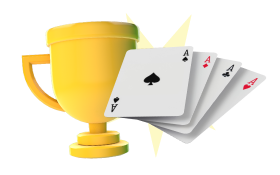
The Hi-Lo is probably the most used system by professional card counters. It is easy to remember, and you only ever need to add or subtract by 1.
Consider the KISS method if you want to track even fewer cards. It’s similar to the Hi-Lo blackjack counting system and just as simple to apply.
Blackjack Card Counting Strategies
Once you know the process and get good at keeping track of everything, you can apply several additional strategies while counting cards.
Deviations and Indexes
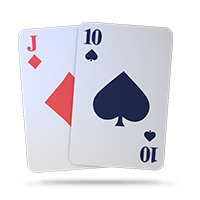
Aside from simply increasing your bet as the shoe changes, most card-counting systems have additional strategic plays to consider. Deviations and indexes, sometimes called index plays, are the suggested specific moves that differ from the basic hit/stand charts.
When you factor in the true count and compare your hand to the dealer’s up card, there are certain instances that you want to change up when to hit, stand or double. Many systems even have their own diagrams to show you the best play for the current situation.
The Illustrious 18 | A Popular Strategy
Blackjack hall of fame and gaming mathematician Donald Schlesinger affectionately called a set of efficient strategic deviations The Illustrious 18, and the name stuck. The table below shows you all of those moves.
| Illustrious 18 | Hand & Dealer Card | Index Count | Move to Make |
|---|---|---|---|
| 1 | Insurance on Dealer A | +3 | Take insurance when +3 or higher |
| 2 | 16 against a 9 | +5 | Stand at +5 or higher |
| 3 | 16 against a 10 | 0 | Stand at 0 or higher |
| 4 | 15 against a 10 | +4 | Stand at +4 or higher |
| 5 | 13 against a 2 | -1 | Stand at -1 or higher, otherwise hit |
| 6 | 13 against a 3 | -2 | Stand at -2 or higher, otherwise hit |
| 7 | 12 against a 2 | +4 | Stand at +4 or higher |
| 8 | 12 against a 3 | +2 | Stand at +2 or higher |
| 9 | 12 against a 4 | 0 | Stand at 0 or higher |
| 10 | 12 against a 5 | -1 | Stand at -1 or higher, otherwise hit |
| 11 | 12 against a 6 | -1 / -3* | Stand at -1 (-3 if the dealer hits on 17) or higher, otherwise hit |
| 12 | 11 against an Ace | +1 / -1* | Double down at +1 (-1 if the dealer hits on 17) or higher |
| 13 | 10 against a 10 | +4 | Double down at +4 or higher |
| 14 | 10 against an Ace | +4 / +3* | Double down at +4 (+3 if the dealer hits on 17) or higher |
| 15 | 9 against a 2 | +1 | Double down at +1 or higher |
| 16 | 9 against a 7 | +4 | Double down at +4 or higher |
| 17 | Pair of 10s against a 5 | +5 | Split at +5 or higher |
| 18 | Pair of 10s against a 6 | +5 | Split at +5 or higher |
Counting Cards in Blackjack with a Team

Another strategy many blackjack card counters use is team play. The goal is for the whole group to make money, with each person executing a specific role.
A “counter” sits at a table or observes the game from behind seated players, indicating a favorable count or passing the current count to other teammates. They are here to gather info, and if playing, always bet the table minimum.
The “big player,” sometimes called a gorilla, only sits down at tables with high positive counts after they have gotten the signal. They bet huge immediately and keep it up until the count falls back.
Some teams also utilize a “spotter” to gather more information and watch the action of employees in the pit. Any data the team gathers could be valuable in beating the house.
Card Counting Practice
The classic saying practice makes perfect definitely applies to card counting. Once you know how to do it in theory, you need to put a system in motion to learn how it works in a real-life situation.
Practice Counting With a Deck of Cards

The easiest way to start learning a card counting system is to grab a deck of cards, shuffle them, and flip them over one by one. It will be a slow process initially as you reference the system’s table and try to remember everything.
The goal here is to memorize the value of each card’s value and keep a running count throughout the entire deck. Once you have that down, you can work on picking up the pace, eventually turning over two, three, or four cards at once.
Once you can count a single deck, progress up to six or eight decks. Since a casino will be full of noise and commotion, it’s also a good idea to eventually incorporate distractions like a TV or radio into your practice.
Learn to Count Cards With Free Online Blackjack
A free blackjack game like the one below is the perfect way to start practicing your card counting system. As you play a hand, try to quickly get the count based on the cards you can see.
Remember, the shoe here doesn’t matter since you’re just trying to gather the info for a single hand. The faster you get, the better you will be at factoring in several hands at a live table and keeping the running count in your head.
Practice Your Card Counting Skills Playing Live Blackjack
Once you have mastered learning the basic rules of blackjack and using basic strategy, getting into a real blackjack game will help you build experience.
You can do this at a land-based casino or play live dealer blackjack online without ever leaving the house.
We recommend you start online. Internet play lets you keep charts and tables handy and removes a lot of distractions.
Plus, you can find virtual tables with lower minimum bets that allow you to stretch your bankroll and play for longer.

3 Blackjack Card Counting Pro Tips
You can do a few things to help avoid having the casinos detect that you are counting cards. Anything you do to deceive the casinos is called camouflage. So here are our top tips to make your card counting camouflage near perfect.
Change Your Appearance
Some professional players go as far as using make-up and different disguises to alter the way they look and avoid detection. The casino may keep your image on file if you get backed off a table. Consider shaving your beard or covering your hair for your next session.Keep Changing Casinos
To avoid too much attention from one establishment, pro card counters rotate casinos regularly. You can’t spend hours and hours counting the same games because, eventually, the casino will figure out what you’re doing.New Shoe vs. In-Play Shoe
Many pros like getting a count before they sit down, but that can raise a red flag. Consider mixing up when you enter a game to prevent alerting the pit bosses to your advantage play tactics.
Up Your Blackjack Game by Counting Cards
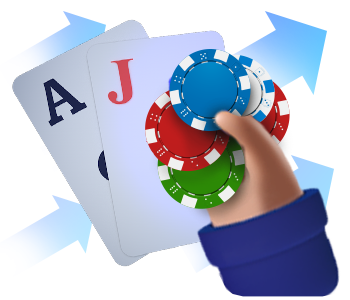
Are you ready to go from casual player to season card shark? Using this guide, you should be able to start counting cards at the blackjack table and gaining a slight edge over the house.
While the skills required are simple, applying everything in real-time and memorizing when to deviate from the basic strategy is where the mastery comes in. Practice is the name of the game, and execution is where it starts to pay off.
Always remember, casinos don’t like card counters. So, be careful out there, and good luck at the tables!
Card Counting FAQ
These are the most common questions we get about card counting.
What is card counting?
Card counting is the technique of keeping track of what cards have been dealt and which ones are left in the shoe to give yourself a statistical advantage. It’s primarily used in blackjack and poker.
Is blackjack card counting different from counting cards in poker?
Card counting is used for different purposes in blackjack and poker. In blackjack, people count cards to give themselves an advantage over the house and will bet high when they have an advantage and low when the dealer does. In poker, counting cards help determine what decisions to make against other players.
Can you count cards in online blackjack?
No, you can’t count cards in online blackjack. The software uses an automated process to shuffle the deck for each hand. It’s all done by a computer and is completely randomized. Even live dealer studios make it difficult by limiting deck penetration.
Does card counting really work?
Yes, it does work and is a successful way to give yourself a statistical advantage. However, don’t bet on being able to get away with it. Most casinos frown on the practice, are keen on identifying it, and will ask you to leave if they even suspect you’re counting cards.
How hard is it to count cards?
Counting cards is easy math in concept, but it can take time and skill to execute. It takes a lot of practice and repetition, and even the best card counters wouldn’t be able to get a good read in a blackjack game with six to eight decks that are regularly shuffled.
What is the best card-counting system?
The Hi-Lo system is the easiest to master, which makes it the most popular way to count cards. Numbers 2-6 get counted as +1, 6-9 get counted as 0, and 10-Ace get counted as -1. The higher the count, the more a player can assume 10s and face cards are left in the shoe.
How to win at blackjack without counting cards?
You don’t need to count cards to win at blackjack. The best thing you can do is practice and learn how to use the basic strategy chart.
Can you make a living with card counting?
It’s questionable if you can make a living card counting. People make careers out of playing blackjack, but it may be unrealistic for the average gambler if casinos start backing them off of tables or banning them from playing.
How often do you win when counting cards?
A good blackjack card counter gains around a 0.5-1% edge against the casino. That means you’re winning just over half of the time and can still encounter losing streaks and bad deck variance.

